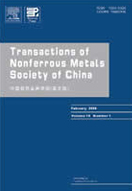Effect of EPS on adhesion of Acidithiobacillus ferrooxidans on
chalcopyrite and pyrite mineral surfaces
chalcopyrite and pyrite mineral surfaces
(Key Laboratory of Biometallurgy of Ministry of Education, School of Minerals Processing and Bioengineering,
Central South University, Changsha 410083, China)
Central South University, Changsha 410083, China)
Abstract: Extracellular polymeric substances (EPS) were extracted from Acidithiobacillus ferrooxidans through sonication method associated with centrifugation, which was evaluated tentatively with 2-keto-3-deoxyoctonic acid (KDO) as the indicator of EPS by spectrophotometry. Then the effect of EPS of A. ferrooxidans on the adhesion on chalcopyrite and pyrite surfaces was studied through a series of comparative experiments. The untreated cells and EPS-free cells of A. ferrooxidans were mixed with EPS suspension, Fe2+ or Fe3+, respectively. The planktonic cells were monitored in 2 h during bioleaching. The results indicate that the presence of EPS on the cell is an important factor for the adhesion to chalcopyrite and pyrite. A decrease of attachment of A. ferrooxidans to minerals was produced by the deficiency of EPS, which can recover mostly when the EPS was re-added into the EPS-free cells. The restoring extent is more obvious in pyrite than in chalcopyrite. The extent of cell adhesion to chalcopyrite increased when EPS and Fe3+ added, and decreased when Fe2+ added, which imply the electrostatic interaction plays a main role in initial adhesion between bacteria and minerals and it is a driving force for bacteria to produce EPS probably as a result of regaining their attachment ability to copper sulphides.
Key words: attachment; Acidithiobacillus ferrooxidan; extracellular polymeric substances; chalcopyrite; pyrite

